
TSOP7000SW1
Document Number 82221
Rev. 1.1, 01-Mar-05
Vishay Semiconductors
www.vishay.com
1
1
2
3
18301
IR Receiver for High Data Rate PCM at 455 kHz
Description
The TSOP7000SW1 is a miniaturized receiver for
infrared remote control and IR data transmission. PIN
diode and preamplifier are assembled on lead frame,
the epoxy package is designed as IR filter.
The demodulated output signal can directly be
decoded by a microprocessor. The main benefit is the
operation with high data rates and long distances.
Features
∑ Photo detector and preamplifier in one
package
∑ Internal Bandfilter for PCM frequency
∑ Internal shielding against electrical field
disturbance
∑ TTL and CMOS compatibility
∑ Output active low
∑ Small size package
Special Features
∑ Data rate 20 kbit/s
∑ Supply voltage 2.7 - 5.5 V
∑ Short settling time after power on
∑ High envelope duty cycle can be received
∑ Enhanced immunity against disturbance
from energy saving lamps
Block Diagram
Application Circuit
10 k
2
3
1
V
S
OUT
Demo-
GND
Pass
AGC
Input
PIN
Band
dulator
Control Circuit
16841
C
1
=
4.7 µF
TSOPxxxx
OUT
GND
Circuit
µC
R
1
= 47
+V
S
GND
Transmitter
with
TSHFxxxx
V
S
R
1
+ C
1
recommended to suppress power supply
disturbances.
V
O
R
2
>=
1 k
R
2
optional for improved pulse forming.
16843
e3

www.vishay.com
2
Document Number 82221
Rev. 1.1, 01-Mar-05
TSOP7000SW1
Vishay Semiconductors
Absolute Maximum Ratings
Absolute Maximum Ratings
T
amb
= 25 ∞C, unless otherwise specified
Electrical and Optical Characteristics
T
amb
= 25 ∞C, unless otherwise specified
Parameter
Test condition
Symbol
Value
Unit
Supply Voltage
Pin 3
V
S
- 0.3 to + 6.0
V
Voltage at output to supply
Pin 1
V
S
- V
O
- 0.3 to V
S
+ 0.3
V
Supply Current
Pin 3
I
S
5
mA
Output Voltage
Pin 1
V
O
- 0.3 to + 6.0
V
Output Current
Pin 1
I
O
15
mA
Junction Temperature
T
j
100
∞C
Storage Temperature Range
T
stg
- 25 to + 85
∞C
Operating Temperature Range
T
amb
- 25 to + 85
∞C
Soldering Temperature
t
10 s, 1 mm from case
T
sd
260
∞C
Power Consumption
P
tot
30
mW
Parameter
Test condition
Symbol
Min
Typ.
Max
Unit
Supply Current (Pin 3)
Dark ambient
I
SD
2.0
2.7
mA
E
v
= 40 klx, sunlight
I
SH
2.3
mA
Supply Voltage (Pin 3)
V
S
2.7
5
5.5
V
Transmission Distance
p
= 870 nm, IR Diode
TSHF5400, I
F
= 300 mA
d
max
20
m
p
= 950 nm, IR Diode
TSAL6400, I
F
= 300 mA
d
max
12
m
Threshold Irradiance
p
= 870 nm,
optical test signal of Fig.1
E
e min
0.8
1.5
mW/m
2
Maximum Irradiance
Optical test signal of Fig.1
E
e max
30
W/m
2
Output Voltage Low (Pin 1)
1 k
external pull up resistor
V
QL
100
mV
Output Voltage High (Pin 1)
No external pull-up resistor
V
QH
V
S
- 0.25
V
Bandpassfilter quality
Q
10
Out-Pulse width tolerance
Optical test signal of Fig.1,
1.5 mW/m
2
E
e
30 W/m
2
tpo
- 15
+ 5
+ 15
µs
Delay time of output pulse
Optical test signal of Fig.1,
E
e
> 1.5 mW/m
2
t
don
15
36
µs
Receiver start up time
Valid data after power on
t
V
50
µs
Falling time
Leading edge of output pulse
t
f
0.4
µs
Rise time
No external pull up resistor
t
r
12
µs
1 k
external pull up resistor
t
r
1.2
µs
Directivity
Angle of half transmission
distance
1/2
± 45
deg

TSOP7000SW1
Document Number 82221
Rev. 1.1, 01-Mar-05
Vishay Semiconductors
www.vishay.com
3
Typical Characteristics (Tamb = 25
∞C unless otherwise specified)
Figure 1. Output Function
Figure 2. Output Fucntion (mit Jitter)
Figure 3. Output Pulse Diagram (t
don
, t
po
)
E
e
V
Q
V
QH
V
QL
Optical Test Signal
(f=455kHz, 10 cycles/burst)
Output Signal of TSOP7000
t
pi
= 22
s
t
t
don
t
po
t
f
16792
2.2
s
t
r
50%
90%
10%
t
po
= t
pi i
15
s
> 48.6
s
(min. duty cycle)
t
E
e
V
O
V
OH
V
OL
t
Optical Test Signal
(IR diode TSHF5400,
p
870 nm, I
F
= 300 mA, f = 455 kHz, 10 cycles/burst)
Output Signal of TSOP7000
j
tdon
t
don
t
po
jitter of leading edge
jitter of output pulse width
j
tpo
16755
t
pi
= 22
s
t
0
5
10
15
20
25
30
35
0.1
1.0
10.0 100.0 1000.010000.0
100000.0
E
e
≠ Irradiance (mW/m
2
)
16790
don
t , t Output Pulse Length ( s )
Output pulse width ≠ t
po
Delay time ≠ t
don
1
10
100 1000 10000 100000
N = 10 cycles/burst
p
o
Figure 4. Jitter of Output Pulse
Figure 5. Frequency Dependence of Responsivity
Figure 6. Sensitivity in Bright Ambient
0
5
10
15
20
25
30
0.1
1.0
10.0
100.0 1000.010000.0
100000.0
E
e
≠ Irradiance (mW/m
2
)
16791
j
N=10 cycles/burst
Jitter ≠ t
don
Jitter ≠ t
po
1
10
100 1000 10000 100000
tdon,
tpo
j
≠
Jitter of Output Pulse ( s )
0.0
0.1
0.2
0.3
0.4
0.5
0.6
0.7
0.8
0.9
1.0
300
350
400
450
500
550
600
f ≠ Frequency ( kHz )
16751
/
E
e min
e
rel
E ≠ Responsitivity
0
2
4
6
8
10
12
14
0.01
0.10
1.00
10.00
100.00
E ≠ DC Irradiance (W/m
2
)
16786
e min
E ≠
Threshold Irradiance (mW/m )
2
Correlation with ambient light sources
(Disturbanceeffect): 10 W/m
2
= 1.4 klx
(Stand.illum.A,T = 2855 K)
10 W/m
2
= 10 klx
(Daylight,T = 5900 K)

www.vishay.com
4
Document Number 82221
Rev. 1.1, 01-Mar-05
TSOP7000SW1
Vishay Semiconductors
Figure 7. Sensitivity vs. Supply Voltage
Figure 8. Rel. Sensitivity vs. Burstlength
Figure 9. Supply Current vs. Ambient Temperature
0.0
0.2
0.4
0.6
0.8
1.0
1.2
1.4
1.6
1.8
2.0
2.0
2.5
3.0
3.5
4.0
4.5
5.0
5.5
6.0
V
S
≠ Supply Voltage ( V )
16787
Sensitivity in dark ambient
e min
E ≠
Threshold Irradiance (mW/m )
2
0.5
0.6
0.7
0.8
0.9
1.0
1.1
N - Burstlength ( carriercycles/burst )
16788
e
min
E
-
Relative
Sensitivity
26
22
18
14
28
24
20
16
12
10
8
1.5
1.6
1.7
1.8
1.9
2.0
2.1
2.2
2.3
5 15 25 35 45 55 65 75 85
T
amb
- Ambient Temperature (
∞C )
16754
I
-
Supply
Current
(
m
A
)
s
V
S
= 5.5 V
V
S
= 2.7 V
-5
-15
-25
Figure 10. Relative Spectral Sensitivity vs. Wavelength
Figure 11. Directivity
0.0
0.2
0.4
0.6
0.8
1.0
1.2
750 800 850 900 950 1000 1050 1100 1150
- Wavelength ( nm )
16789
S(
)
-
Relative
Spectral
Sensitivity
rel
0.0
0.1
0.2
0.3
0.4
0.5
0.6
0.7
0.8
0.9
1.0
≠90≠75≠60≠45≠30≠15 0 15 30 45 60 75 90
Angle (deg)
96 12223
Relative T
ransmission
Distance

TSOP7000SW1
Document Number 82221
Rev. 1.1, 01-Mar-05
Vishay Semiconductors
www.vishay.com
5
Recommendation for Suitable Data For-
mats
The circuit of the TSOP7000SW1 is designed in that
way that disturbance signals are identified and unwa-
ted output pulses due to noise or disturbances are
avoided. A bandpass filter, an automatic gain control
and an integrator stage is used to suppress such dis-
turbances. The distinguishing marks between data
signal and disturbance are carrier frequency, burst
length and the envelope duty cycle.
The data signal should fullfill the following conditions:
∑ The carrier frequency should be close to 455 kHz.
∑ The burstlength should be at least 22
µs (10 cycles
of the carrier signal) and shorter than 500
µs.
∑ The separation time between two consecutive
bursts should be at least 26
µs.
∑ If the data bursts are longer than 500
µs then the
envelope duty cycle is limited to 25 %
∑ The duty cycle of the carrier signal (455 kHz) may be
between 50 % (1.1
µs pulses) and 10 % (0.2 µs
pulses). The lower duty cycle may help to save bat-
tery power.

www.vishay.com
6
Document Number 82221
Rev. 1.1, 01-Mar-05
TSOP7000SW1
Vishay Semiconductors
Package Dimensions in mm
18016

TSOP7000SW1
Document Number 82221
Rev. 1.1, 01-Mar-05
Vishay Semiconductors
www.vishay.com
7
Ozone Depleting Substances Policy Statement
It is the policy of Vishay Semiconductor GmbH to
1. Meet all present and future national and international statutory requirements.
2. Regularly and continuously improve the performance of our products, processes, distribution and
operatingsystems with respect to their impact on the health and safety of our employees and the public, as
well as their impact on the environment.
It is particular concern to control or eliminate releases of those substances into the atmosphere which are
known as ozone depleting substances (ODSs).
The Montreal Protocol (1987) and its London Amendments (1990) intend to severely restrict the use of ODSs
and forbid their use within the next ten years. Various national and international initiatives are pressing for an
earlier ban on these substances.
Vishay Semiconductor GmbH has been able to use its policy of continuous improvements to eliminate the use
of ODSs listed in the following documents.
1. Annex A, B and list of transitional substances of the Montreal Protocol and the London Amendments
respectively
2. Class I and II ozone depleting substances in the Clean Air Act Amendments of 1990 by the Environmental
Protection Agency (EPA) in the USA
3. Council Decision 88/540/EEC and 91/690/EEC Annex A, B and C (transitional substances) respectively.
Vishay Semiconductor GmbH can certify that our semiconductors are not manufactured with ozone depleting
substances and do not contain such substances.
We reserve the right to make changes to improve technical design
and may do so without further notice.
Parameters can vary in different applications. All operating parameters must be validated for each
customer application by the customer. Should the buyer use Vishay Semiconductors products for any
unintended or unauthorized application, the buyer shall indemnify Vishay Semiconductors against all
claims, costs, damages, and expenses, arising out of, directly or indirectly, any claim of personal
damage, injury or death associated with such unintended or unauthorized use.
Vishay Semiconductor GmbH, P.O.B. 3535, D-74025 Heilbronn, Germany
Telephone: 49 (0)7131 67 2831, Fax number: 49 (0)7131 67 2423

Legal Disclaimer Notice
Vishay
Document Number: 91000
www.vishay.com
Revision: 08-Apr-05
1
Notice
Specifications of the products displayed herein are subject to change without notice. Vishay Intertechnology, Inc.,
or anyone on its behalf, assumes no responsibility or liability for any errors or inaccuracies.
Information contained herein is intended to provide a product description only. No license, express or implied, by
estoppel or otherwise, to any intellectual property rights is granted by this document. Except as provided in Vishay's
terms and conditions of sale for such products, Vishay assumes no liability whatsoever, and disclaims any express
or implied warranty, relating to sale and/or use of Vishay products including liability or warranties relating to fitness
for a particular purpose, merchantability, or infringement of any patent, copyright, or other intellectual property right.
The products shown herein are not designed for use in medical, life-saving, or life-sustaining applications.
Customers using or selling these products for use in such applications do so at their own risk and agree to fully
indemnify Vishay for any damages resulting from such improper use or sale.







